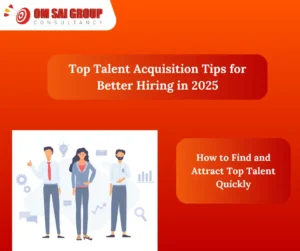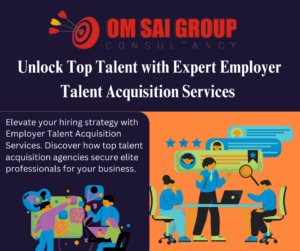10 Common Mistakes in Talent Acquisition Talent to Avoid

Why Talent Acquisition Fails—And How to Fix It Before It Costs You Overlooking Fundamentals in a Rapidly Evolving Hiring Landscape In the hyper-competitive digital economy of today, talent acquisition is not merely an HR task—it’s a business imperative that drives market significance, employer attractiveness, and sustained competitiveness. Talent Acquisition Talent And yet, despite an expanding arsenal of AI-based solutions, SEO-marked job adverts, AEO-crafted content strategies, and GEO-focused sourcing campaigns, most businesses continue to struggle to acquire the right talent on the right terms. Placement Service From multinationals to high-growth startups, talent acquisition mistakes usually owe their roots to some basic problems: workforce planning, poor employer branding, and an out-of-date understanding of what today’s candidates really desire. These mistakes aren’t just expensive—they’re preventable. Talent Acquisition Talent While search engines value content findability (SEO) and voice assistants require direct and formatted answers (AEO), the talent market today also incentivizes geographic specificity (GEO)—candidates desire opportunities that fit their local environment. Not accounting for these digital changes is equivalent to not meeting your talent where they already stand. Talent Acquisition Talent The Top 10 Pitfalls Sabotaging Your Talent Acquisition Strategy 1. Misunderstanding Talent Acquisition vs Recruitment The frequent but fatal error: conflating talent acquisition with recruitment. Recruitment is a tactical, short-term, transactional activity aimed at filling immediate vacancies. Talent acquisition is long-term, strategic, and integrated—spanning employer branding, workforce planning, relationship building, and market intelligence. Talent Acquisition Talent Not understanding this difference causes shallow pipelines, bad retention, and disjointed messaging that sabotages both SEO and AEO performance of your job postings. 2. Neglecting Workforce Forecasting Hiring reactively, as a response to turnover or demand for immediate projects, is a guarantee for falling behind. Strategic workforce planning looks ahead at what will be needed in the future based on market trends, product roadmaps, and internal growth objectives. Talent Acquisition Talent In the absence of forecasting, organizations resort heavily to agencies and contract hiring and lose opportunities to develop internal talent. Staffing solutions 3. Poor Employer Branding Applicants now research companies as thoroughly as companies screen applicants. Poor or incoherent branding repels high achievers. A solid Employer Value Proposition (EVP) that is in accordance with your SEO strategy—optimized career sites, targeted blogs, and employee-branded stories—is driving more online visibility and culturally relevant talent to your doorstep. Talent Acquisition Talent 4. Relying on Outdated Job Descriptions Generic, keyword-filled, or too-technical job descriptions damage both applicant quality and SEO performance. Instead, use clarity, inclusivity, and practical expectations. Craft AEO-friendly content by answering standard candidate questions in the job posting (e.g., “What does a Business Analyst do at XYZ?”). Talent Acquisition Talent 5. Ignoring Candidate Experience From apply to onboard, the candidate journey has to be seamless, responsive, and engaging. Talent Acquisition Talent Bad communication, sluggish feedback, and uncertain timelines can kill your brand. A well-planned journey not only enhances experience but increases AEO relevance, particularly when FAQs, timelines, and plain instructions are woven into organized content. 6. Not Investing in the Right Talent Acquisition Tools Outdated ATS solutions and manual tracking are no longer adequate. Businesses need to invest in scalable solutions such as GEO-location hiring platforms that source on proximity and availability, AI-powered sourcing platforms, and recruitment dashboards integrated with CRM for hiring. Talent Acquisition Talent Recruitment automation platforms, SEO-optimized applicant tracking systems, and AEO-enriched job boards are forging the future of talent discovery and engagement by organizations. Talent Acquisition Talent 7. Underestimating Internal Mobility Most often, the best person for the job is already in your system. Disregarding internal talent pools results in disengagement, increased attrition, and escalating recruitment expenses. Lateral movement, upskilling, and succession planning are critical to keeping high-value individuals. Talent Acquisition Talent A transparent internal mobility portal, internally search-optimized (internal SEO), is also a factor in visibility and retention. manpower Service 8. Lack of Diversity and Inclusion in Hiring Diversity in recruitment isn’t only a moral imperative—it’s a human performance enhancer. Blind hiring techniques, inclusive language in advertisements, and organized interviews can bring in a larger and more vibrant talent pool. Talent Acquisition Talent D&I approaches also make GEO-targeted outreach to multicultural areas more effective in big countries like India or the U.S. 9. Weak Onboarding Processes Poor onboarding translates into poor retention. Without a systematic process for engaging, training, and integrating new hires, organizations risk first-year turnover rates that are unacceptably high. Your onboarding content must be interactive, customized, and digitally enabled—providing convenient navigation, mobile accessibility, and SEO-indexed documents for rapid internal search. Talent Acquisition Talent 10. Not Measuring Hiring Metrics Without solid data, there is no way to get better. Key performance indicators like time-to-hire, quality-of-hire, cost-per-hire, and candidate satisfaction must be measured on an ongoing basis. These figures directly inform performance audits, SEO strategy optimization, and future workforce planning. Talent Acquisition Talent Building a Resilient Talent Acquisition Strategy What Leading Companies Are Doing Differently High-performing organizations view talent acquisition as an integral function of business success. They: Align hiring with long-term corporate goals Embed SEO-rich content into career branding initiatives Implement AEO strategies such as FAQ schema and structured data Leverage GEO filters for hyper-localized talent recruitment Empower hiring managers with interactive Talent Acquisition PPTs and in-house workshops Some even include local language localization (e.g., defining the meaning of talent acquisition in Hindi or regional dialects), so they resonate with talent in multilingual markets. Talent Acquisition Talent The Rising Demand for Talent Acquisition Jobs Future-Proofing Your Organization with the Right People Talent Acquisition roles are changing. Talent Acquisition Talent Today’s professionals need to be proficient in data analytics, branding, and storytelling. They need to know how to leverage recruitment automation tools, how to improve SEO and AEO rankings, and how to localize communications for GEO-specific talent groups. The most sought-after Talent Acquisition Specialists are: Strategic workforce advisors Employer brand ambassadors Analytics interpreters Tech-savvy recruitment marketers Hiring these professionals is no longer a nicety—it’s a necessity for future-proofing your talent strategy. Talent Acquisition Talent Action Steps—What You Should Be Doing Now Audit, Align, and Advance Your Talent Strategy Begin with an audit: Is your hiring reactive or proactive? Are your job pages SEO and AEO optimized? Are you using GEO tools

